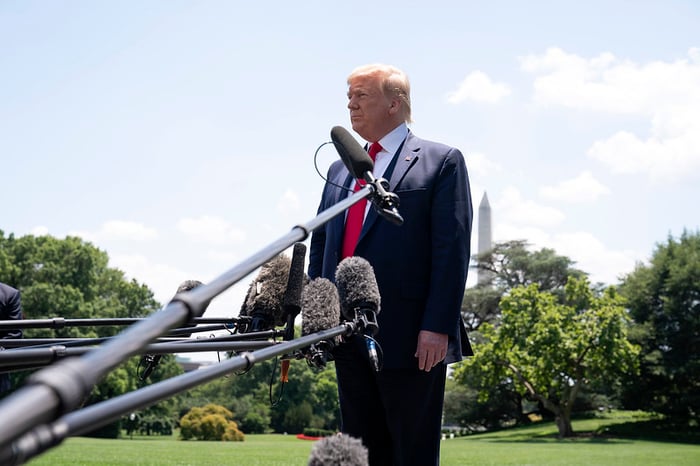Tariff Policy Under Trump: Market Implications and Investor Sentiment
President Donald Trump promised significant changes upon entering office, and his administration did not disappoint. He implemented extensive tariffs on imports from numerous countries, aiming to address what he views as longstanding inequities in global trade that disadvantage the U.S.
The announcement of tariffs on April 2 triggered a sharp decline in stock prices, pushing both the S&P 500 and Nasdaq Composite indexes into bear market territory. However, stocks saw a quick recovery when Trump declared a 90-day moratorium on tariffs, allowing for potential trade negotiations.
By May 2, despite a nine-day winning streak, the S&P 500 still recorded its worst performance during a president’s first 100 days since 1974, with a decline of about 8%. Investors are left wondering what the next 100 days will hold.
Strategic Trade Negotiations with Key Partners
As of this writing, the Trump administration is 24 days into its 90-day pause on tariffs. While there have been discussions regarding trade agreements with significant partners like India and Japan, no formal agreements have been established. Tensions with China, however, have escalated. Trump has raised tariffs on many Chinese goods to a cumulative rate of 145%. In response, China has imposed cumulative tariffs of 125% on U.S. imports, indicating a firm stance from its leadership.
Recent reports suggest Chinese officials may be open to trade talks with the U.S. after repeated inquiries from senior U.S. officials. A spokesperson for China’s commerce secretary stated that any dialogue would require the U.S. to remove unilateral tariffs to avoid undermining mutual trust.
Establishing agreements with essential trading partners like China is crucial for stabilizing the stock market. Many companies have cautioned about the repercussions if Trump reinstates his high tariffs, warning of potential price increases and job losses. Market strategists are also indicating the possibility of an impending recession. Consequently, these trade discussions will likely keep investors vigilant as market fluctuations respond to developments.

Official White House Photo by Joyce N. Boghosian.
Investors Monitoring Recession and Stagflation Risks
Despite the grace period for tariffs, signs of a recession have intensified as recent economic data fluctuates. The first quarter saw U.S. gross domestic product (GDP) contract by 0.3%. Some economists attribute this decline to businesses rushing to import goods ahead of the tariffs, leading to inflated import figures. However, the April jobs report provided a silver lining, with unemployment steady at 4.2%, indicating a potentially resilient labor market.
Should U.S. GDP experience another contraction, the economy would officially be in a technical recession. Additionally, indicators are revealing weaknesses in consumer spending. The uncertainty added by tariffs complicates the macroeconomic outlook further. The Federal Reserve is adopting a wait-and-see approach as it considers the potential for rising consumer prices due to tariffs.
The Fed’s concern is to avoid rising prices while economic growth slows and unemployment climbs, a scenario that could lead to stagflation. This condition would hinder the Fed’s ability to lower interest rates to stimulate growth without risking inflation and further labor market deterioration.
These dynamics create a climate ripe for market volatility. Even with recent gains, the U.S. economy faces considerable challenges, and the ultimate outcome of Trump’s tariff policies remains uncertain.
Given these conditions, investors are encouraged to adopt a long-term perspective. Attempting to capture short-term gains in such an unpredictable environment carries significant risk. Historical trends indicate that longer investment horizons generally yield better outcomes. Maintaining composure amid market volatility can be advantageous over time.
Should You Invest in the S&P 500 Index Now?
Before committing funds to the S&P 500 Index, consider the following:
The analyst team at Motley Fool has identified what they believe are the 10 best stocks to buy right now, and the S&P 500 Index is notable for being excluded from this list. These selected stocks are projected to generate impressive returns in the coming years.
For example, when Netflix was recommended on December 17, 2004, a $1,000 investment would now be worth $623,685!* Similarly, an investment in Nvidia on April 15, 2005, would have grown to $701,781!*
It’s essential to note that Stock Advisor has a total average return of 906%, significantly outperforming the 164% return of the S&P 500.
See the 10 stocks »
*Stock Advisor returns as of April 28, 2025
Bram Berkowitz has no position in any of the stocks mentioned. The Motley Fool has no position in any of the stocks mentioned. The Motley Fool has a disclosure policy.
The views and opinions expressed herein are those of the author and do not necessarily reflect those of Nasdaq, Inc.



